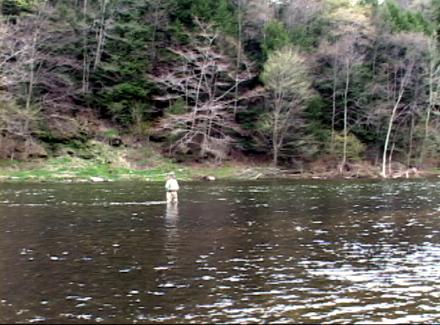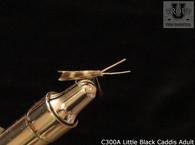
The Delaware River is one of the major rivers on the Atlantic coast of the United States. It forms part of the boundary between Pennsylvania and New York, all of the boundary between New Jersey and Pennsylvania, and indeed most of the boundary between Delaware and New Jersey.
However, we are interested in the northern portions of the Delaware including the West Branch which is the tailwater of Cannonsville Reservoir, the East Branch which is the tailwater of Pepacton Reservoir, and the main portion of the Delaware from Hancock, NY to Callicoon, NY approximately 25 miles. The Delaware offers a wide variety of aquatic insects, small fish, and populations of crustaceans capable of supporting a healthy population of trout. It is often said that the Delaware River is one of the best tailwater streams in the Eastern portion of the USA.
The West Branch from Deposit, NY to Hancock, NY is the most popular section of the river for fly anglers. Fast water starts just below the dam, then slows somewhat as it flows past some islands. The uppermost mile or more of the river, above a weir dam, is closed to fishing. Below the weir dam the water stays clear and cold throughout the entire year. After the islands, the main channel is characterized by short riffles and longer pools. The gradient is gentle and the bottom of the West Branch is easily waded when the releases from the dam permit it. Route 17 runs along the east bank of the river in this area providing many access points.
The trout populations in the West Branch of the Delaware River are brown trout, with some rainbows, and an occasional brookie. All the trout are wild as the state does not stock the West Branch of the Delaware River. The West Branch is known for very large browns and a 33-inch lunker brown was once taken in the no-kill stretch.
The lower section of the West Branch starts at Hale Eddy and continues to the junction of the East Branch of the Delaware forming the border of Pennsylvania and New York State. As such, the fishing license is reciprocal between the states for this portion. As you go downstream, the water becomes warmer and the frequency of rainbows increases.
Anglers come from across the nation to fish its Caddisfly, Hendrickson, and Sulphur hatches, as well as generous amounts of stoneflies and midges. There is no-kill section located from Rt.17 Bridge down river for two miles. This section probably holds as much as 1,000 trout per mile for two miles. The West Branch is by far the most publicized portion of the Delaware and because it is one of the premier tailwater streams in the East, it gets a great deal of angling pressure. So, the successful angler must step up to the challenge by precisely matching the hatch.
The East Branch of the Delaware River is the tailwater of Pepacton Reservoir; it is cold and it flows slowly as well. A canoe is the best method of fishing this portion of the Delaware because there are dense beds of aquatic grasses in its rich waters. Brook trout dominate the upper stretches but the brown trout populations increase as you go further downstream. Brown trout, as large as 26 inches can be taken from the East Branch.
A few miles downstream from the dam it is joined by the more famous Beaverkill, its largest tributary. The upper portion of the East Branch is accessible from Route 30 on the West and Harvard Road on the East bank. However, permission will often be required from the landowners since much of the land is private.
The lower portion of the East Branch from the Beaver Kill to Hancock, can be accessed from route 17 which remains above the stream. The waters in this portion can become quite warm in the summer stressing the trout, so caution is in order.
The main section of the Delaware River has the largest browns and they are all wild. This portion is known as “the Big D” and it holds much promise for the anglers. The “Big D” waters contain deep pools, and large sharp boulders providing cover for the browns. Matching the hatch precisely is extremely important in this portion of the Delaware. The river can be waded in this portion but most of the popular access points have been closed so, a guide with a drift boat is highly recommended.
Presentation of the fly is especially important when fishing the Delaware since it is so large. Long casts under windy conditions are often necessary so a nine-foot rod and 5X leaders are preferred and keep the line as short as possible to avoid drag in the less currents.
Check out our Delaware River Hatch Chart.
Spring:
The Delaware River is known for its famous mayfly hatches and has several varieties of mayflies. Spring is the most popular time to fish the river starting with the mayfly hatches, followed by the sulphurs as well as the hatches of other aquatic insects. In the springtime when water spills over the top of the Cannonville Dam some large trout can be taken. Do not expect to be alone on the river.
Summer:
The water released from the two dams stays cool, especially near the dams, throughout the summer and provides good trout fishing. In early June the Brown and Green Drake emergence with the spinners falling give anglers a perfect opportunity for taking big trout. The nighttime emergence of stoneflies and big salmonflies often reward anglers with rainbows and browns up to 24 inches.
Fall:
Fall is the favorite time of many angles because it is less crowded. The scenery as well as the fishing is usually excellent. Terrestrials remain good as are the streamers imitating the small fry and minnows.
Winter:
As with any tailwater river, the fishing remains good during the winter because the water remains a constant temperature. Near the dams, the flow of the water prevents the normal ice that would ordinarily blanket the water.
The upper portion of the East Branch is accessible from Route 30 on the West and Harvard Roadon the East bank.
The lower portion of the East Branch from the Beaver Kill to Hancock, can be accessed from route 17 which remains above the stream. Route 17 runs along the east side of the West Branch of the Delaware riverarea providing many access points, and in Hancock, easy access is found at the bridge on Rt. 191
View Northeast USA in a larger map





